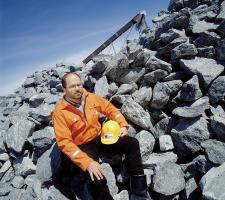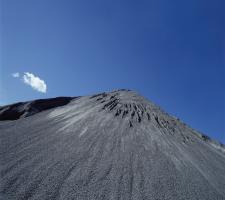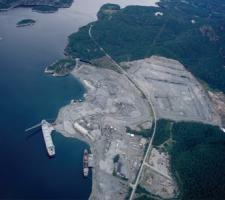
The largest aggregates quarry in Norway is going full speed ahead on expansion plans, with its owners investing 'a lot of money' to increase production and make it a world-beater. Patrick Smith visited the site
The high-speed ferry from the coastal town of Stavanger in south-west Norway to the equally picturesque village of Jelsa takes about an hour.
Along the route up the Ryfylke Fjord, snow-capped mountains add to the breathtaking scenery, while homes have been built to take full advantage of the views.
Yet this idyllic setting in the Rogaland region, which like other parts of Norway is one of the country's biggest assets and a huge attraction to tourists, may well be a drawback when it comes to employment.
One of the major employers in the area is
Some 95% of the aggregates produced are shipped directly from Jelsa Quarry and exported to Germany, Denmark, France, and the UK, the four main markets, with Germany taking 50% of this amount. The rest is used locally in Norway.
"With the expansion we need another 30 to 40 people. This is really a challenge. The scenery around here is beautiful as you can see, but distances and communications can be improved," said Norsk Stein's managing director Jan Øyvind Jørgensen. The car journey from Stavanger to Jelsa takes three hours, with two car ferries along its route.
"It is an excellent area for families. They can have an amazing quality of life: the nature, and then the mountains are only 20 minutes away where you can ski or go to a mountain cabin. It is quiet compared to Stavanger (the biggest settlement in the region), and this does not appeal to everyone.
"We are looking for operators in the production area and drivers for the dump trucks and wheel loaders. We are also looking for mechanics, and we need these people next year so they will be ready when the new production line starts in April 2009," said Jørgensen. "I am after a project manager, and it is a challenging task to find one." The quarry at Jelsa, which produces high quality aggregates for asphalt and concrete; road construction; railway ballast (filling material around rail tracks); stones for coastal defense, and offshore gravel used to secure oil/gas pipelines at the sea bottom, is the largest in Norway, and employs 87 people (mining engineers, mining technicians, electricians, mechanics, accountants, shipping agent, process technicians, drivers and welders). With the expansion it will become the largest coastal quarry in Europe, and eventually one of the largest of its kind in the world.
"With a production of over 10 million tonnes, we will definitely be one of the largest in the world. Even with 4.6 million tonnes we are already the largest in Norway and one of the largest in Europe." The existing quarry will go on but it will be extended to cover a total of some 1,200 acres.
Norsk Stein is jointly owned by
"All the shipping from Jelsa is arranged from Stema in Denmark along with the sales of all the materials we produce here. We sell the products to Stema and they organise the sales," said Jørgensen.
Company established
"Norsk Stein was established in 1987, and production started here at Jelsa in 1988," explained Jørgensen, who joined the company in 2001, and who is overseeing the quarry expansion.
"Originally the quarry was owned by local people. There was a crushing station available from a hydro-electric project in the mountains. At the time it was one of the biggest projects in Norway.
"The crushing station was taken down and Norsk Stein obtained the rights to extract the rock." When Jørgensen started at Jelsa it was producing about 2.6 million tonnes of aggregates and some rock armour (used for protective walls like those alongside the quarry quay and to support the base of stockpiles). Last year production had risen to over 4.6 million tonnes, and the plan is to increase production up to 8 million tonnes, and possibly more, by 2009 when the new production line will be completed.
Originally, the plan was to leave a natural rock 'wall' between the old quarry, which would have been filled with water, overburden, production waist and landscaped, and open up new operations next to this. It has now been decided to extend, and work removing soil and trees to expose bare rock is already underway.
And with reserves of some 350 million tonnes, it is estimated that the quarry will remain in operation for 40 to 50 years, after which it will be returned to nature in the form of a big lake, along with planting.
Indeed, the environment (and in particular the affects of noise and dust) are high on Norsk Stein's list of priorities both as a company and because of legal requirements.
The way we were
Norsk Stein has committed itself to a contract that defines how the area is to be developed.
"Before the stone quarry was initiated, the area was considered not to be economically viable with respect to development or agricultural use," says the company.
"When the quarrying is finished, some parts of the stone quarry will be an industrial area, and the rest will be a big lake with nice threes around. Thus we will contribute to heal the wound and leave no scars." This is one reason why the heart of the quarry is a completely covered production facility where bedrock, which has been blasted in the quarry, is crushed and screened into various fractions (sizes), currently using a variety of equipment mainly from
"The owners of Norsk Stein need a long time horizon for operation in order to justify their investment. I cannot say how much this is, but it is a lot of money," said Jørgensen. "The longer we can extract stone at Jelsa, the more money our owners can justifiably invest in operations. In this type of industry, a long time perspective is very common." For example, one quarry in the municipality of Vanylven has received approval for a development plan for a quarry which will ensure resources for 500-600 years, and in Bremanger permission has been granted for a quarry development with a lifetime of some 250 years.
Production process
"The crushing of rock makes noise. This is why we do our utmost to shield the local environment from the noise," said Jørgensen. "In Norway, there are rules and regulations regarding noise limits and which noise levels could damage health. We comply with these. At the same time, Norway also allows for industrial operations 24-hours-a-day, all year round. And this is what we do at Jelsa today, and will continue doing.
"Dust reduction is one of our main points of focus for the future. We will work hard to keep dust discharges to a minimum."
The quarry at Jelsa contains base rock with hard and durable varieties of granite, gneiss or granodiorite, and blasting to retrieve it takes place normally once a week.
Paul Ivar Hov, Norsk Stein's blasting team leader, points out that the floor of the existing quarry is just 5m above sea level, and the company has already started to go further down in some sections to minus 11m. The top of the quarry is about 100m above sea level.
Prior to blasting there is surface sampling of the rock, and rock cores are then also taken.
He says that the holes for blasting are carefully mapped out, and drilling is carried out using four main drilling machines, all
When the 12-13m deep holes, with diameters of 3.5", 4", 5.5" or 6" have been drilled, the explosive materials, supplied by Orica Mining Services, are pumped in from a truck. The holes are then sealed and a slurry material is inserted, followed by the detonator: a thin wire with a special central core is used to set off the charge.
Orica Mining Services has built its own plant within the quarry confines, with a number of people working full-time with Norsk Stein, its main customer locally.
The amount of rock blasted each week ranges anywhere between 60,000tonnes and 300,000tonnes, but this will increase to 400,000tonnes to 500,000tonnes.
"We are always looking to improve and optimise blasting in the quarry. This will give us the best size of stones for crushing. We want less fines in our blasted product and we want the optimal sizes for the primary crusher," said Jan Øyvind Jørgensen.
Export praise
A confirmation of Norsk Stein's export efforts was highlighted in 1995 when the company received the Erling Skjalgsson Award.
The prize is given to companies in Rogaland County that have achieved good results through determined work in the export market. Norsk Stein was the first company to receive the award.Following blasting, the company's 100tonne
The final products are achieved by using the tertiary crushing plants, three Metso GP550 cone crushers, which have a typical capacity range of between 160-500tonnes per hour.
A wide range of screening equipment, including a Lokomo (Metso Minerals) B16 1.6m x 5.6m; Bräuer 2.5 x 6; Braüer 2 x 5; two IFE U2S 2 x 6; three Ibag EGKD 2.5 x 6, and two IFE Trisomat 2 x 7.2, is used to screen the crushed rock into its various sizes. This is then sent by conveyor belts to the stockpiles.
"The size of aggregates we produce here varies from 0-300mm, but the majority of it is between 0-32mm (see chart)," said Jørgensen.
"All the processes are fully automated and are directed from a control room housed in a specially-built facility, which is manned 24 hours a day in line with the workings of the quarry," said Jørgensen.
"All the equipment in the room was tailor-made for this specific task and was supplied by Siemens. The control room has a bank of screens which monitor the crushing operation from start to finish via sensors and cameras.
"For example, if a large piece of rock gets stuck in the primary crusher this can be seen on one of the monitors. The operator can then remotely operate a rock hammer which will break down the size so that it can proceed through the crusher. The control room was upgraded in 2003-2004. We also have an on site laboratory with four people. In here they test the quality of all the materials that are produced." Tests include particle size distribution, fines content, shape of coarse aggregate, particle density and water absorption, and water content.
New project
One of the company's biggest projects is to install the new semi mobile primary crusher station in the existing quarry, away from the present quayside facility.
"As you can see our existing facility is a little distance from the quarry, and it makes more sense to have the primary crusher near the newly blasted rocks. It makes transport easier and saves time and money.
"We have just signed a contract for the new primary crusher with ThyssenKrupp. We chose this particular crusher after a long and thorough technical and economical evaluation," said Jørgensen.
"One of the major problems at present with all the new production equipment is the delivery times. This is a real issue for suppliers. Worldwide, we found that delivery times have doubled because demand for this kind of equipment has increased, particularly in big mines, and this does affect us.
"We had to push very hard to get the crusher delivered from ThyssenKrupp by 1 April this year. It is a TKFKB 63 inch x 75 inch unit.
"For the secondary and tertiary crushing we are working with the three main suppliers (Metso Minerals,
All the finished materials from the quarry are shipped out of Jelsa in vessels belonging to Stema Shipping. When the quarry is expanded a new quay will be built near the existing facility to cater for the extra production.
There are two 27,000tonne ships; one 18,000tonne ship and one 8,000tonne ship as the major part of the fleet.
"Two more 30,000tonne ships have been ordered and those will be here by April 2009," said Jørgensen.
The Jelsa plant is situated within short shipping distances to the most important markets in Germany, Denmark, the UK and France, and the main harbour, which has an 18m draft, is protected and is ice-free throughout the year. It can handle ships up to 40,000 tonnes The smaller vessels are self-discharging by means of onboard excavator. The bigger vessels are discharged by using an onboard conveyor belt system. A boom, giving an outreach of 20-70m, depending on the vessel, is situated at the bow of the vessels. The boom can swing up to 90° either side of the ship, giving flexibility in how material is discharged. This allows not only for minimal crushing of the material, but also very quick discharge rates. Depending on vessel type and material, the discharge rate varies between 1,200 to 3,000tonnes per hour.of view the operation will be much quieter, although as he points out there are few people living near the quarry.
"In the new production area we will cover as much as we can to reduce the dust. This is one of the two main problems that have to be addressed in quarries: the other is noise. As you can see we cover as much as we can for the dust and we are improving the area and investing a lot of money." Another area where Jørgensen sees room for improvement is in the stockpiling of finished aggregates. At present the storage capacity for each fraction is about 25,000tonnes.
"We have to get a better stockpiling system here. There is not a lot around for the aggregate business, although there is a lot of effort put into stockpiling in the mining and coal industries, and we are looking at these.
"When we increase stockpiles we have to look into different solutions, and what we are looking for is something new. We need a lot of stockpiling, but we want to reduce the handling. We are looking into new systems that are used in the mining industry but not as yet in the aggregate business.
"Ideally we would like something that does not involve a wheel loader." Today there are tunnels underneath the stockpiles and these lead directly into the ships via a conveyor belt near the quayside.
"We will keep the existing tunnels, and while as yet I am not sure what stockpiling system we will choose, we must decide by 1 July." As for the future? "We have become much more professional and industrialised in the last five years, and in ten years' time there will be fewer quarries, but they will be much bigger.
"Control systems are extremely important as the customer is much more demanding these days. Logistics is also very important to us because we are shipping directly to the customer." And pointing to a pile of invites on the desk of his on site office, Jan Øyvind Jørgensen says that he will certainly be at the

















